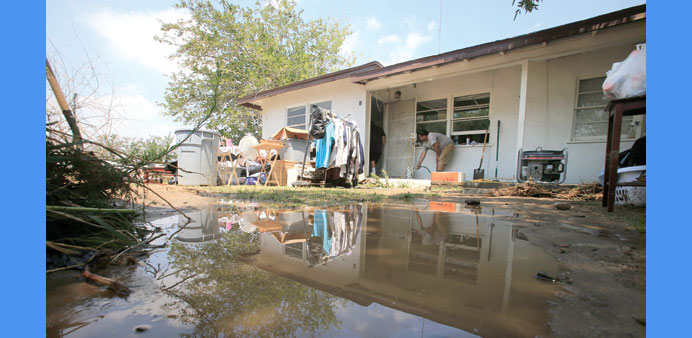FLOODED: Pools of water are formed after mud and rain water made its way into a residential area in Highland, California.
By Steff Gaulter
Last week, drought-hit California was drenched by torrential rain. Rain is fairly unusual at this time of year, but was generated by a violent hurricane, called Hurricane Norbert. The storm churned up the east coast of Mexico, at one point becoming a powerful category three on the five-point Saffir-Simpson scale which is used to rate the strength of hurricanes.
Fortunately the storm stayed away from the coast until it started to disintegrate and the worst of the winds had eased.
The remnants of the storm raged over Mexico’s Baja California, but it injected moisture into the atmosphere above much of western Mexico and also the southwest of the USA. Thunderstorms developed across the region, producing torrential downpours, which in turn triggered landslides and flash flooding. Despite the intensity of some of the downpours, however, a drought still holds strong in much of California. The state has been in the grip of a drought for the past three years, and it’s been steadily getting worse. According to the US Climate Prediction Center, the shortfall in rain during the last three years has been equivalent to an entire year’s worth.
Most of the year’s rain that southern California receives usually falls in the winter. A thin ribbon of strong winds high up in the atmosphere, known as the jet stream, regularly guides storms towards the west coast of the USA in the cooler months. These winds are known as the Pineapple Express, because they deliver the rain directly from Hawaii.
San Francisco, for example, usually receives 85% of its rain in the five months between November and March. If this rain fails, then the state often has water problems for the entire year.
Over the past few years, the winter jet stream has shifted northwards and the vital winter rains have failed to materialise. This has left the state in the grip of its worst drought for a century. This is a major problem for a state which produces 99% of all almonds and walnuts grown in the US, 92% of strawberries and 90% of tomatoes.
California has a history of water problems; the rain is far heavier in the north of the state, but the majority of the population live in the south. In the north, some places receive over 900mm (35 inches) of rain per year, but further south, the rainfall is far less. Los Angeles, with its population of almost 4mn, has an annual rainfall of 379mm (15 inches), but further inland, Bakerfield has an annual rainfall of less than 144 mm (5.7 inches), which is only twice the expected yearly rainfall in Doha.
Much of Southern California relies for its water supply on a network of reservoirs, aqueducts, power plants and pumping plants, known as the California State Water Project. This moves water from the water-rich north to the parched south. The Water Project doesn’t only use rain water, but also snow melt from the mountains; particularly important is the snow melt from the Sierra Nevada and the Cascade Mountains. Unfortunately the snow has been in even shorter supply in recent years than the rain, thanks to a couple of unusually warm winters.
The temperature across the Sierra Nevada last winter was approximately 3C (5 to 6F) above the norm. This greatly reduced the amount of accumulated snow, known as the snowpack, and therefore also reduced the amount of water that was generated when it melted. The rainfall was about 60% of the average, but the snowpack was only about a third or a quarter of the average.
This had a substantial impact on the amount of water available to both residential customers and businesses. The Water Project supplies water to two-thirds of California’s population, 70% of which goes to urban users and 30% to agriculture.
There were hopes that fortunes could soon be about to change. In May, the major weather agencies were all in agreement that there was a high probability of El Nino materialising between June and August. El Nino is the slight warming of the surface waters of the Pacific Ocean. Although the change in temperature is usually no greater than about 2C (3.5F), it often has a dramatic effect on the weather around the world.
In Australia, it often brings a drought to much of the east of the country. In the USA, however, the same phenomenon is often responsible for plentiful rains in California. The strong 1997-98 event correlated with San Francisco’s biggest recorded rain year: a whopping 1199mm (47.2 inches) of rain, almost double its average of 601mm (23.7 inches).
However, despite the forecast of its imminent arrival, El Nino had other ideas. It now looks unlikely that El Nino will develop before 2015, and when it does develop, it is expected to be a very mild event. Whilst this news was greeted with cautious optimism by farmers in Australia, in California the news was greeted with disappointment. Whilst the rain could still fall in California this winter, it is now far less likely to be the above average, drought busting rains that are so greatly needed.

